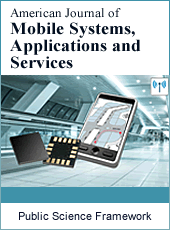American Journal of Mobile Systems, Applications and Services
Articles Information
American Journal of Mobile Systems, Applications and Services, Vol.1, No.2, Oct. 2015, Pub. Date: Sep. 2, 2015
A Comparative Study on the Two Popular Cognitive Radio Spectrum Sensing Methods: Matched Filter Versus Energy Detector
Pages: 132-139 Views: 5936 Downloads: 1489
[01]
Shahriar Shirvani Moghaddam, Faculty of Electrical Engineering, Shahid Rajaee Teacher Training University, Tehran, Iran.
[02]
Mehrnoosh Kamarzarrin, Dept. of Electrical and Computer Engineering, Shahid Beheshti University, Tehran, Iran.
In this paper, two well-known cognitive radio spectrum sensing (CR-SS) methods, energy detection (ED) and matched filter (MF), are numerically realized in time domain (TD) as well as frequency domain (FD). Simulations for both ED and MF methods demonstrate the similar results (probability of detection) in the similar conditions for TD and FD versions of each method. In contrast, the required processing time (or equally computational complexity) for TD realization of each method is higher than that for FD realization. In addition, the running time of MF is higher than that for the ED. Furthermore, in similar conditions, the false alarm rate for MF method is less than that for the ED which means higher accuracy for the MF method compared to the ED. Moreover, it is observed that the ED is more sensitive to threshold and in a small range of threshold, detection values will be changed, sharply. Finally, simulation results demonstrate that signal to noise ratio (SNR) has direct effect on the receiver operating characteristic (ROC), especially for the ED method.
Cognitive Radio (CR), Spectrum Sensing (SS), Energy Detection (ED), Matched Filter (MF), False Alarm, Miss Detection, Time Domain, Frequency Domain
[01]
S. Yuhang, "Spectrum Sensing in Cognitive Radio Systems," Bachelor’s Thesis in Electronics, Gavle, 2011.
[02]
H. Sun, A. Nallanathan, C.-X. Wang, and Y. Chen, "Wideband Spectrum Sensing for Cognitive Radio Networks: A Survey," IEEE Wireless Communications, Vol. 20, No. 2, pp. 74- 81, April 2013.
[03]
H. Sun, A. Nallanathan, J. Jiang, and H. Vincent Poor, "Compressive Autonomous Sensing (CASe) for Wideband Spectrum Sensing," IEEE International Conference on Communications (ICC), Ottawa, pp. 4442-4446, 10-15 June 2012.
[04]
B. Wang, K. J. Ray Liu, "Advances in Cognitive Radio Networks: A Survey," IEEE Journal of Selected Topics in Signal Processing, Vol. 5, No. 1, pp. 5-23, February 2011.
[05]
H. Sun, "Cooperative Spectrum Sensing with Diversity Reception in Cognitive Radios," 6th International ICST Conference on Communications and Networking in China (CHINACOM), Harbin, pp. 216-220, 17-19 August 2011.
[06]
H. Sun, D.-I. Laurenson, J.-S. Thompson, and C.-X. Wang, "A Novel Centralized Network for Sensing Spectrum in Cognitive Radio," IEEE International Conference on Communications (ICC), Beijing, pp. 4186-4190, 19-23 May 2008.
[07]
S. Haykin, "Cognitive Radio: Brain-Empowered Wireless Communications," IEEE Journal on Selected Areas, Vol. 23, No. 2, pp. 201–220, Feb. 2005.
[08]
M. Subhedar, G. Birajdar, "Spectrum Sensing Techniques in Cognitive Radio Networks: A Survey," International Journal of Next-Generation Networks (IJNGN), Vol. 3, No. 2, pp. 37-51, June 2011.
[09]
Y. Hur, J. Park, W. Woo, J. S. Lee, and J. Laskar, "WLC05-1: A Cognitive Radio (CR) System Employing A Dual-Stage Spectrum Sensing Technique: A Multi- Resolution Spectrum Sensing (MRSS) and A Temporal Signature Detection (TSD) Technique," IEEE Global Telecommunication Conference (GLOBECOM), San Francisco, pp. 1-5, 27 Nov. - 1 Dec. 2006.
[10]
Y.-J. Tang, Q.-Y. Zhang, and W. Lin "Artificial Neural Network Based Spectrum Sensing Method for Cognitive Radio," 2010 International Conference on Computational Intelligence and Software Engineering, Chengdu, pp. 1-4, 23-25 Sept. 2010.
[11]
A. Ghasemi, E. S. Sousa, "Spectrum Sensing in Cognitive Radio Networks: Requirements, Challenges and Design Trade-offs Cognitive Radio Communication and Networks," IEEE Communications Magazine, Vol. 46, No. 4, pp. 32-39, 2008.
[12]
S. Chatterjee, J. Sekhar Roy, and P. P. Bhattacharya, "Spectrum Sensing Techniques for Cognitive Radio-A Survey," International Journal of Applied Engineering Research (IJAER), Vol. 10, No. 7, pp. 16665-16684, 2015.
[13]
D. B. Rawat, G. Yan, and C. Bajracharya, "Signal Processing Techniques for Spectrum Sensing," International Journal of Ultra Wideband Communications and Systems, Vol. 11, No. 1, pp. 1-10, 2010.
[14]
I. Budiarjo, M. K. Lakshmanan, and H. Nikookar, "Cognitive Radio Dynamic Access Techniques," Wireless Personal Communications (WPC), Vol. 45, pp. 293-324, 2008.

ISSN Print: 2471-7282
ISSN Online: 2471-7290
Current Issue:
Vol. 5, Issue 1, March Submit a Manuscript Join Editorial Board Join Reviewer Team
ISSN Online: 2471-7290
Current Issue:
Vol. 5, Issue 1, March Submit a Manuscript Join Editorial Board Join Reviewer Team
| About This Journal |
| All Issues |
| Open Access |
| Indexing |
| Payment Information |
| Author Guidelines |
| Review Process |
| Publication Ethics |
| Editorial Board |
| Peer Reviewers |


